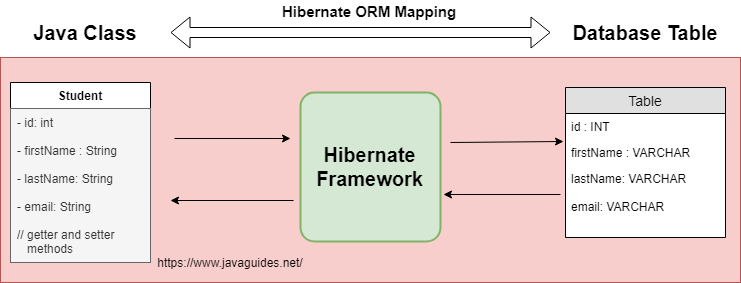In this blog post, we will learn what is ORM, what is JPA. what is Hibernate, Hibernate architecture, and What are the important benefits of using the Hibernate Framework?
Hibernate is the most popular JPA implementation and one of the most popular Java ORM frameworks. Hibernate is an additional layer on top of JDBC and enables you to implement a database-independent persistence layer. It provides an object-relational mapping implementation that maps your database records to Java objects and generates the required SQL statements to replicate all operations to the database.
What is ORM?
ORM (Object-relational mapping) is a programming technique for mapping application domain model objects to relational database tables. Hibernate is a Java-based ORM tool that provides a framework for mapping application domain objects to relational database tables and vice versa.
What is the Java Persistence API (JPA)?
The Java Persistence API (JPA) is a Java specification for accessing, persisting, and managing data between Java objects/classes and a relational database. JPA acts as a bridge between object-oriented domain models and relational database systems, making it easier for developers to work with data in their applications.JPA allows developers to map Java objects to database tables and vice versa using annotations or XML configuration files. This abstracts the complexities in converting data between its object-oriented form in the application and its relational form in the database.
JPA is not an implementation but a specification. Various ORM tools, such as Hibernate, EclipseLink, and Apache OpenJPA, provide implementations of the JPA specification. This allows developers to switch between these implementations if needed without changing the application code that uses JPA.
What is the Hibernate Framework?
Hibernate is a Java-based ORM tool that provides a framework for mapping application domain objects to relational database tables and vice versa.
Key Features of Hibernate
Transparent Persistence: Hibernate manages the persistence of objects without requiring significant changes to how those objects are designed.
Database Independence: Applications built with Hibernate are portable across databases with minimal changes.
Performance Optimization: Features like caching and lazy loading help optimize performance by reducing database access.
Powerful Query Language: Hibernate Query Language (HQL) offers an object-oriented extension to SQL, easing data manipulation and retrieval.
Automatic Schema Generation: Hibernate can generate database schemas based on the object model, simplifying initial setup and migrations.
How does Hibernate relate to JDBC?
Hibernate internally uses JDBC for all database communications.
Hibernate acts as an additional layer on top of JDBC and enables you to implement a database-independent persistence layer:
Hibernate acts as an additional layer on top of JDBC and enables you to implement a database-independent persistence layer:
Hibernate Architecture
Hibernate architecture consists of several layers, including the Java application layer, Hibernate framework, backhand API, and the database layer. Let's break down the core components:SessionFactory
A thread-safe, immutable cache of compiled mappings for a single database. SessionFactory is a heavyweight object, usually created during application initialization and kept for later use.Session
A single-threaded, short-lived object representing a conversation between the application and the database. It acts as a factory for Transaction instances and holds a first-level cache of retrieved data.Transaction
A unit of work with the database represents an abstraction of the application from the underlying transaction implementation (JTA or JDBC).ConnectionProvider
Manages the database connections needed by Hibernate sessions. It abstracts the application from underlying connection management mechanisms.TransactionFactory
Creates Transaction instances, hiding the underlying transaction implementation details from the application.What are the important benefits of using the Hibernate Framework?
Code Efficiency: Hibernate significantly reduces boilerplate code associated with JDBC, allowing developers to concentrate on business logic and speeding up development time.Flexibility in Code: By supporting both XML configurations and JPA annotations, Hibernate ensures code independence from the implementation, enhancing portability across different database systems.
Advanced Query Capabilities: HQL (Hibernate Query Language) offers an object-oriented alternative to SQL, seamlessly integrating with Java's object-oriented features like inheritance, polymorphism, and associations.
Community and Documentation: As an open-source project backed by the Red Hat Community, Hibernate benefits from widespread use, a shallow learning curve, extensive documentation, and robust community support.
Integration with Java EE Frameworks: Hibernate's popularity and support make it easily integrated with other Java EE frameworks, notably Spring, which offers built-in Hibernate integration for seamless development.
Performance Optimization: Features like lazy loading, where database operations are deferred until necessary, and caching mechanisms significantly improve application performance.
Vendor-Specific Features: Hibernate allows for native SQL queries, providing flexibility to utilize database-specific optimizations and features when needed.
Comprehensive ORM Tool: With its extensive feature set addressing nearly all ORM tool requirements, Hibernate stands out as a leading choice in the market for object-relational mapping solutions.
What are the advantages of Hibernate over JDBC?
Simplified Code: Hibernate significantly reduces boilerplate code required in JDBC, making the codebase cleaner and more readable.Advanced Mapping Features: Unlike JDBC, Hibernate fully supports object-oriented features such as inheritance, associations, and collections.
Transaction Management: Hibernate seamlessly handles transaction management, requiring transactions for most operations, which contrasts with JDBC's manual transaction handling through commit and rollback.
Exception Handling: Hibernate abstracts boilerplate try-catch blocks by converting JDBC's checked SQLExceptions into unchecked JDBCException or HibernateException, simplifying error handling.
Object-Oriented Query Language: HQL (Hibernate Query Language) offers an object-oriented API, which aligns it more with Java programming concepts than JDBC's need for native SQL queries.
Caching for Performance: Hibernate's support for caching enhances performance, a feature not available with JDBC, where queries are directly executed without caching.
Database Synchronization: Hibernate can automatically generate database tables, offering greater flexibility than JDBC, which requires pre-existing tables.
Flexible Connection Management: Hibernate allows for both JDBC-like connections and JNDI DataSource connections with pooling, which is essential for enterprise applications and not supported by JDBC.
ORM Tool Independence: By supporting JPA annotations, Hibernate-based applications are not tightly bound to Hibernate and can switch ORM tools more easily than JDBC-based applications, which are closely coupled with the database.



Comments
Post a Comment
Leave Comment